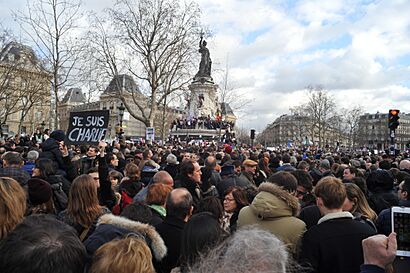Republican marches facts for kids
Quick facts for kids Republican marches |
|
|---|---|

Demonstrators at the Place de la République, Paris, 11 January 2015
|
|
| Date | 10 January 2015 – 11 January 2015 |
| Location | |
| Caused by | Charlie Hebdo shooting (mainly) |
| Goals | Fight against terrorism Freedom of speech Freedom of the press |
| Methods | Rallies, marches |
| Number | |
| 3.7 million in France 100k+ internationally Attended by over 80 world leaders |
|
The Republican marches (French: Marches républicaines) were huge public gatherings in France and other countries. They happened on January 10–11, 2015. People marched to honor the victims of several attacks that had just taken place. These included the Charlie Hebdo shooting, the Montrouge shooting, and the Porte de Vincennes siege.
The marches were also a way for people to show their support for freedom of speech and freedom of the press. This means the right to express your thoughts and ideas without fear, and the right for journalists to report the news freely.
The French government said that about 3.7 million people joined the marches across France. This made them the largest public gatherings in French history. They were the biggest public movement since 1944, when Paris was freed from German control at the end of World War II.
Contents
Why People Marched
The main reason for the Republican marches was to show support for important values like freedom of speech and freedom of the press. These values are about being able to say and write what you think. They are very important in a free society.
People also wanted to remember and honor those who had lost their lives in the recent attacks. The marches were a way for many people to stand together and show they would not be scared by violence.
Where the Marches Happened
The marches took place in many cities across France and even in other countries.
Marches in France
In Paris, the capital of France, a huge number of people gathered. It was thought that between 1.5 and 2 million people marched. They walked from Place de la République to Place de la Nation. Many world leaders, including the French President François Hollande, joined the march in Paris. More than 80 leaders from different countries were there.
Other French cities also saw large marches:
- Over 300,000 people marched in Lyon.
- More than 100,000 people marched in cities like Rennes, Toulouse, Bordeaux, Grenoble, Montpellier, and Marseille.
Major Cities and Numbers on January 10
- Toulouse: 150,000 – 180,000 people
- Nantes: 75,000 people
- Marseille: 45,000 people
- Strasbourg: 45,000 people
- Lille: 35,000–40,000 people
- Besançon: 30,000 people
- Nice: 30,000 people
- Limoges: 30,000 people
- Pau: 30,000 people
Major Cities and Numbers on January 11
- Paris: 1,500,000–2,000,000 people
- Lyon: 330,000 people
- Bordeaux: 140,000 people
- Rennes: 115,000 people
- Grenoble: 110,000 people
- Montpellier: 100,000 people
- Clermont-Ferrand: 70,000 people
- Saint-Étienne: 70,000 people
- Marseille: 65,000 people
- Brest: 65,000 people
- Nancy: 50,000 people
- Strasbourg: 45,000 people
- Toulon: 45,000 people
- Angers: 45,000 people
- Metz: 45,000 people
Marches Around the World
People also held marches and rallies in many cities outside France to show their support.
- Brussels, Belgium: 20,000 people
- Berlin, Germany: 18,000 people
- Vienna, Austria: 12,000 people
- Amsterdam, Netherlands: 18,000 people (on January 8)
- New York City, USA: 2,000 people (on January 10) and more on January 11.
- Montreal, Canada: Many people gathered.
- Dublin, Ireland: 4,000 people
- Stockholm, Sweden: 3,000 people
- Washington, D.C., USA: 3,000 people
Important People Who Attended
Many important people joined the marches, especially in Paris. They came from France and from countries all over the world.
French Leaders and Public Figures
- François Hollande (President of France)
- Manuel Valls (Prime Minister of France)
- Nicolas Sarkozy (former President of France)
- Many former Prime Ministers like Jean-Marc Ayrault, Édouard Balladur, Édith Cresson, Dominique de Villepin, François Fillon, Alain Juppé, Lionel Jospin, Jean-Pierre Raffarin, and Michel Rocard.
- The Mayor of Paris, Anne Hidalgo.
- Leaders of different political parties.
- Important religious leaders, including the President of the French Council of the Muslim Faith and the Rector of the Grand Mosque of Paris.
- Writers, actors, and journalists.
World Leaders and Officials
Many leaders from other countries traveled to Paris to join the march. This showed global support for France and for freedom of speech.
- Angela Merkel (Chancellor of Germany)
- David Cameron (Prime Minister of the United Kingdom)
- Benjamin Netanyahu (Prime Minister of Israel)
- Abdullah II of Jordan (King of Jordan) and Queen Rania
- Matteo Renzi (Prime Minister of Italy)
- Mariano Rajoy (Prime Minister of Spain)
- Donald Tusk (President of the European Council)
- Jean-Claude Juncker (President of the European Commission)
- The Secretary General of NATO, Jens Stoltenberg.
- Representatives from the United Nations and UNESCO.
Some people, like cartoonist Luz, who survived the Charlie Hebdo attack, felt that while the support was "wonderful," the marches might have been used by politicians in ways that didn't fully match the magazine's values. Another cartoonist, Willem, said he didn't want support from certain far-right politicians.
Leaders Who Did Not Attend
Some important leaders did not attend the march in Paris. For example, the Prime Minister of Iceland and the President of the United States, Barack Obama, did not go. Their offices said it was due to short notice and security reasons. However, their countries were still represented by other officials.
Images for kids









